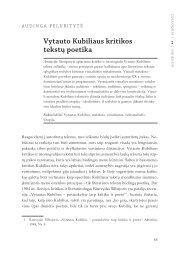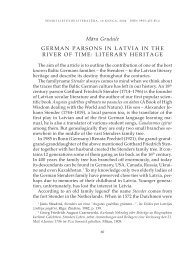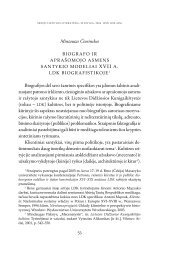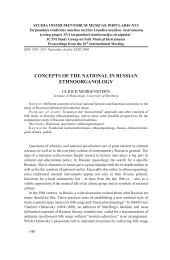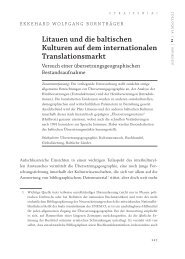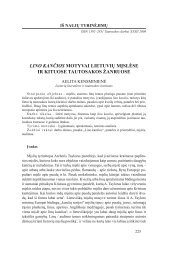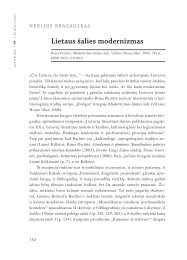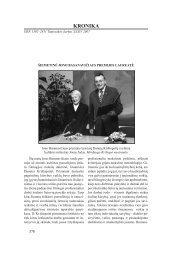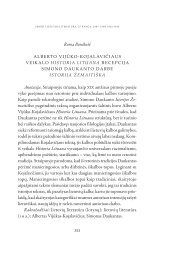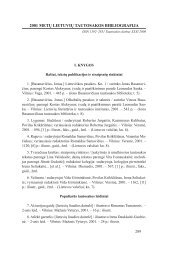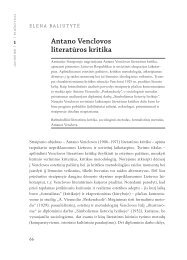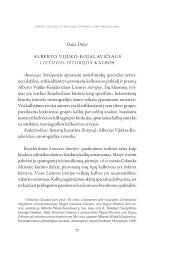PACAS OR PAZZI? NEW INTERPRETATION OF PALAEMON ...
PACAS OR PAZZI? NEW INTERPRETATION OF PALAEMON ...
PACAS OR PAZZI? NEW INTERPRETATION OF PALAEMON ...
You also want an ePaper? Increase the reach of your titles
YUMPU automatically turns print PDFs into web optimized ePapers that Google loves.
<strong>PACAS</strong> <strong>OR</strong> <strong>PAZZI</strong>? <strong>NEW</strong> <strong>INTERPRETATION</strong><br />
<strong>OF</strong> <strong>PALAEMON</strong> LEGEND<br />
IN HIST<strong>OR</strong>ICAL LITERATURE <strong>OF</strong> THE GDL<br />
Summary<br />
In the seventeenth century a tradition to originate Lithuanian noble family Pacas<br />
from Italy was born. According to this mythical provenance story, the Pacas family<br />
related into kinship with the Florentine patrician family Pazzi, of which one member<br />
came to Lithuania with legendary Palaemon and other Roman nobles. Many art historians<br />
interpreted this legend and researches of cultural history as phenomenon of cultural<br />
orientation of the Pacas family, which influenced their art patronage, based on Italian<br />
style Baroque foundations. However, the issue of the Pacas „Italian“ origin in historical<br />
literature of the Grand Duchy of Lithuania (henceforth GDL) was not researched by<br />
scholars yet, possibly for prevalent opinion in historiography that this tradition did not<br />
have written sources and it existed only as oral tradition of this noble family. Therefore,<br />
the aim of this article is to analyze the legend of presumed kinship between the<br />
Lithuanian noble family Pacas and the Florentine patrician family Pazzi and its source<br />
as well as development in historical literature of the GDL.<br />
It is supposed that the beginning of presumed kinship between Pacas and Pazzi could<br />
started after the treasurer’s and vice-chancellor’s of the GDL Stephen Pacas travel in<br />
Italy, when he accompanied the king of Polish-Lithuanian Commonwealth Vladislav<br />
the IV in his traveling through the Europe in 1624-1625. During this travel, S. Pacas<br />
visited Florence and the House of Cosimo Pazzi as the member of this family accepted<br />
him. In Rome during the audience to the Pope, S. Pacas, as the descendant from the<br />
House of Pazzi, accepted as well. This experience S. Pacas described in his diary Obraz<br />
dworów Europejskich… [The Image of European Courts...]. Probably, the idea about the<br />
parentage was based on similar sounding surnames of these noble families as well as of<br />
their particular interest in it, otherwise the legend of this presumed kinship did not<br />
became so popular. First, for the Pacas this parentage with famous Italian noble family<br />
Pazzi helped to overcome the dominant in the GDL Radvilas family as their strongest<br />
opponent and to reach the leadership in the political life of the GDL. Meanwhile, for the<br />
Pazzi the presumed kinship with the rich Lithuanian noble family was useful as well.<br />
This fact testified that one of the members of Pazzi family Lorenzo Domenico de’Pazzi<br />
passed to the court of the Pacas and even reached the title of count in royal court of the<br />
Polish-Lithuanian Commonwealth under protection of his influential relatives. On the<br />
other hand, this supposed kinship was useful for the Medici House because L. D. de’<br />
Pazzi worked as an informer for the court. From the sixteenth century, the Medici aspired<br />
to the Polish crown and the ambitions to obtain it they did not lose even in the<br />
seventeenth century. The interest of the Papacy in the „Italian“ origin of the Pacas one<br />
can find in the spread of the Counter Reformation in the Eastern Europe and the war<br />
against heretics and Turks, as well. Consequently, papal nuncios Pietro Vidoni, Galeazzo<br />
Marescotti, and Opitio Pallavicini propagated that the Pacai were originating from<br />
Florence.<br />
Presumably, all these sources, mentioned above, caused the formation written<br />
tradition in historical literature of the GDL about the „Italian“ origin of the Pacas. The<br />
first written sources of this legend were from the first half of the seventeenth century. It<br />
167
mentioned in the list of arms of Lithuanian nobles Nomenclator familiarum et stemmatum<br />
Magni Ducatus Lithuaniae et provinciarum ad eum pertinentium, written in 1648 by Jesuit<br />
A.V. Kojalavičius [pl. W.W. Kojałowicz]. Another one is in the description of the Pacas<br />
genealogy in Descritione Poloniae et Lithuaniae, written by Martino Zeilero in 1647.<br />
According to these writings the origin of the Pacai family came from their „progenitor“<br />
Cosmus Paccius – Roman consul the eldest pontificate Consul Romanus Pontifex Maximus,<br />
presumably lived II–I cent. BC. His relatives came to Lithuania together with legendary<br />
Palaemon and they started the House of Pacas. The Pazzi family believed to be<br />
originating from the same Roman consul Cosmus Paccius as well. Therefore, the first<br />
two, geographically distant, noble families related into the supposed kinship from the<br />
same Roman „progenitor“.<br />
Later this legend existed in genealogies and in panegyric literature through all<br />
seventeenth and eighteenth centuries. However, the story of the legend complemented<br />
with Christian motifs influenced by the ideas of the Counter Reformation in the second<br />
half of the seventeenth century: first was the piety of the Pacas to their supposed relative<br />
saint Mary Magdalena de’Pazzi as well as the historical theme of the First Crusade to<br />
Jerusalem. The legend interpretations were typical for the historical literature of the<br />
GDL in the seventeenth and eighteenth centuries. Meanwhile, from the second half of<br />
the eighteenth century spread a different version about the presumed parentage between<br />
the Pacas and the Pazzi. In that story, the mythic part about Roman „progenitor“ Cosmus<br />
Paccius did not exist any more, but the origin of the Pacas was started directly from<br />
medieval Italy when several members of the Pazzi family flied to Lithuania from the<br />
despotism of Medici. This interpretation was particularly popular in the nineteenth<br />
century, in the French historiography, probably because of the big interest to Medieval<br />
culture in that epoch. Nevertheless all those interpretations inspired by political interests,<br />
the legend about the Pacas kinship with Florentine patrician family the Pazzi became<br />
an important tradition of the House of Pacas which existed until the middle of the<br />
nineteenth century – the decadence of this family. However, the most important fact is<br />
that this legend about the Pacas „Italian“ origin expressed their cultural aspiration that<br />
all the time was closely related to the spiritual and cultural values of Western Europe.<br />
168



